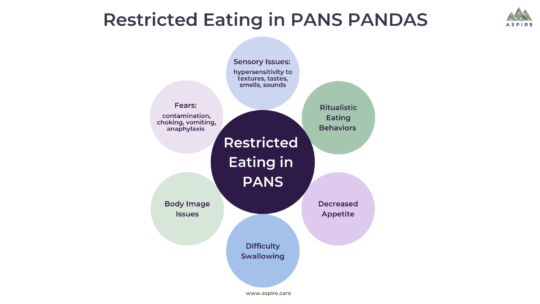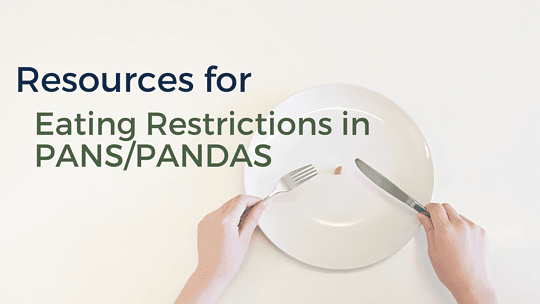
PANS & Eating Disorder/Food Restrictions & Toolkits/Handouts
PANS PANDAS & Eating Disorders/Food Restrictions – Full Packet of Recent studies and Flyer. Please note that the Flyer is also available in two poster sizes...
The PANS Diagnostic Criteria require the new or worsening of OCD and/or severely restricted eating along with symptoms from two out of seven categories. However, many patients have many more symptoms than just the required ones. It is interesting to note that the somatic symptoms such as urinary frequency, mydriasis, and insomnia, help differentiate PANDAS from Tourette syndrome or non-PANDAS OCD.
Dr. Miroslav Kovacevic presented on PANS PANDAS symptom frequency at the PANS/PANDAS Advisory Summit in 2017. The PANS Research Consortium pooled data several members collected within their practices.

PANS has multiple triggers, severities, and symptoms. It is essentially a spectrum disorder. Referring to PANS as a spectrum disorder does not mean it is part of the Autism Spectrum Disorder. It means that one patient with PANS can have very different profiles due to variations in symptomology and triggers. This graphic is only an example of symptoms, severity, and triggers. This graphic is not meant to encompass every combination possible. It is to convey that one cannot assume that because they know one patient with PANS, every patient is going to be similar.
Learn more about PANS and Autism in ASPIRE’s Professional Advisory Board’s Toolkit on PANS/PANDAS Guidelines for Children with Autism. This informational toolkit discusses the unique challenges of diagnosing PANS PANDAS in children with Autism, what it can look like in the school setting, the PANS diagnostic criteria, and treatment guidelines.
Learn more about PANS & PANDAS Symptom Severity
Learn more about PANS PANDAS Disease Course

PANS PANDAS & Eating Disorders/Food Restrictions – Full Packet of Recent studies and Flyer. Please note that the Flyer is also available in two poster sizes...

Restricted eating, including Avoidant/Restrictive Food Intake Disorder (ARFID), is a common yet complex challenge for individuals with PANS/PANDAS. Families and patients often struggle to find...

No matter the length of time a student misses school, communication between families, school professionals and medical professionals is essential to making sure the student’s needs are met....

PANS & Eating Restrictions This section on Restrictive Eatings at School is part of a larger section on Restrictive Eating seen in PANS PANDAS. Make sure to read the entire...

Track and Rate PANS PANDAS Symptoms Tracking symptoms is a critical part of making a clinical diagnosis and forming treatment plans. ASPIRE has assembled the most used symptom tracking and...

PANS/PANDAS is not the same as traditional OCD or a tic disorder; the onset and concurrent symptoms and, in some cases, the severity of the OCD set these disorders apart....

What is the relationship between PANS & PANDAS and Tourette Syndrome? Susan Swedo, MD and Gabriella True sit down to discuss the relationship between PANS & PANDAS and Tourette syndrome....

Sensory & Motor Abnormalities are one of the main PANS PANDAS symptom categories In PANS, sensory and motor abnormalities both fall into one of the seven categories of the PANS...

At first glance, someone PANS and someone with OCD may appear pretty similar. They both have obsessions, compulsions, anxiety, and these symptoms cause significant distress, interfere with daily...

Development and Retention of Fine Motor and Handwriting Skills By Jennifer Leiman M.S. OTR/L PANS PANDAS can affect many aspects of daily functioning. One of the categories of the PANS...

Anxiety is a major symptom of PANS and PANDAS. See more about the PANS PANDAS Diagnostic Criteria and Symptoms. Generalized Anxiety, particularly Separation Anxiety, a hallmark...

Sleep disturbances are common in children with PANS and are part of the diagnostic criteria. See more about the PANS PANDAS Diagnostic Criteria and Symptoms Some have trouble falling asleep...
Learn about other families whose lives have been affected by PANS/PANDAS — and be inspired to share your own.